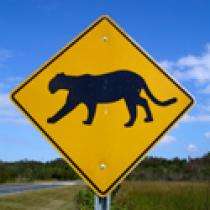Probing Question: What are wildlife corridors?

Imagine that an unknown force hacks your city into two chunks. Because of this new barrier, you can’t get from your home to your office or the grocery store. Suddenly, your access to critical resources is restricted and your life is immeasurably more difficult.
Some animals face a similar dilemma when a road slices through their territory, or urban sprawl or agriculture chews up the meadow where they used to live or eat—activities environmentalists say lead to “habitat fragmentation.” Fragmentation is a leading threat to the survival of many terrestrial animals, and it tends to most affect species that roam far and wide.
One solution? Wildlife corridors—narrow strips of habitat linking bigger wild habitat patches—can help affected animals, according to wildlife conservation professor Richard Yahner of Penn State University.
“Corridors are like a sidewalk for animals; they help them to get from one point to another,” Yahner says. “But a lot goes into designing a wildlife corridor so that the target animal will actually use it.”
Wildlife corridors are usually designed with “umbrella species” in mind, he explains. These are large animals with widespread popular appeal like wolves, mountain lions, or elk that need a lot of land and tend to garner public support. Protecting their habitat, which is often large, can extend protection to smaller species that share the same space, like songbirds and foxes. In this way, an umbrella species shields many other species that fall under its habitat “umbrella.”
Yahner says there is not a lot of agreement on how wide corridors should be, but he suggests that they should be no less than the focal animal’s home range, and the habitat it contains should meet the focal animals needs. For example, a 1,988-mile long proposed corridor would link ecosystems from Yellowstone National Park to Canada’s Yukon Territory, encompassing 502,000-square miles. Such expansive corridors protect multiple species, but they also ensure genetic diversity by allowing gene flow between distant wildlife populations.
Most corridors are smaller. The proposed Halfmoon Wildlife Corridor in Pennsylvania aims to conserve 106 acres that contain rare scrub habitat and imperiled species such as the golden-winged warbler and Appalachian cottontail rabbit.
Corridors can’t be too long or some species won’t use them, Yahner said, and they should appear to be natural, meaning they should have an asymmetrical shape with elements of randomness.
To make a corridor work, scientists must understand the target animal’s habitat needs and the ecology of its movement. For instance, said Yahner, migratory birds may only need isolated stopover points at measured intervals, but migratory butterflies might need a continuous corridor to get from Mexico to North America. In 2000, Mexico created the Monarch Butterfly Biosphere Reserve within a pivotal forest that was suffering fragmentation. Now a UNESCO World Heritage site, the reserve links to other conserved forests and provides vital over-wintering habitat that monarchs need for their multi-generational journeys.
But sometimes, animals just need help crossing a road. Yahner said that in Florida, the state with the highest concentration of roads per square mile, wildlife underpasses help the Florida panther move throughout its habitat, now criss-crossed with highways. An underpass in panther habitat may also help black bears, bobcats, alligators, marsh rabbits or coyotes to slip safely beneath busy roads. Banff National Park in western Canada uses wildlife overpasses to help elk, moose and bears move between the eastern and western sides of the park, which is bisected by a four-lane interstate. These designs also benefit drivers by reducing collisions with large wildlife.
Yahner said there is a big difference between “creating” a corridor from scratch and “ensuring” that a corridor remains. Creating a corridor usually means engineering a new habitat and replanting trees and underbrush to mimic an animal’s preferred environment, whereas ensuring a corridor means identifying pivotal tracts of land in their natural state that should be shielded from development.
He said it is difficult to predict whether or not a particular corridor will work, and success can only be assessed on a case-by-case basis after they are in use. Camera traps and monitoring for tracks and scat are among the methods researchers use to document how animals use corridors, but a building body of work is making clear that for plants, corridors do work to maintain and even increase biological diversity.
“We should always err on the side of ensuring connectivity,” Yahner said. “We cannot go wrong if we do that."
Provided by Pennsylvania State University (news : web)














